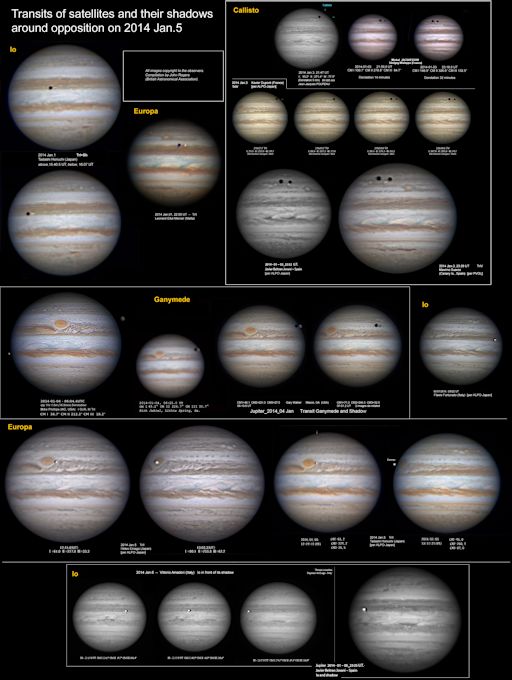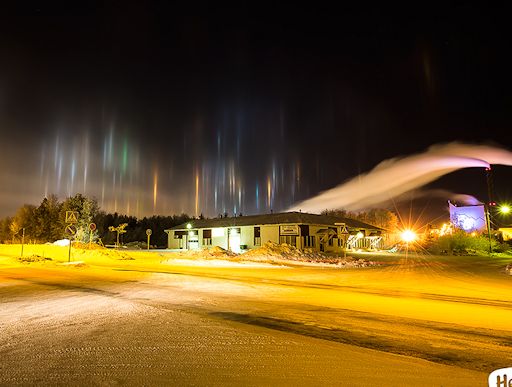SOLAR SECTOR BOUNDARY CROSSING: High-latitude auroras are possible on Jan. 21st when Earth crosses through a fold in the heliospheric current sheet. This is called a "solar sector boundary crossing," and NOAA forecasters estimate a 25% chance of polar geomagnetic storms when it occurs. Aurora alerts: text, voice.
FASCINATING PHENOMENA OF JUPITER'S MOONS: On Jan. 5th, Earth passed directly between the sun and Jupiter. Astronomers call this an "opposition" because the sun and Jupiter were on opposite sides of the sky. "Jupiter's opposition is always an opportunity for beautiful pictures of moons transiting Jupiter, sometimes directly in front of their own shadows," says John H. Rogers, Jupiter Section Director of the British Astronomical Association. "Observers have produced some fine examples from the opposition earlier this month." Some of the best are collected here:
Transits around opposition are beautiful, but something even more rare and special is coming this fall. "In autumn, Jupiter's moons will begin a series of mutual eclipses and occultations," Rogers says. The satellites will criss-cross in the sky, dipping in and out of one another's shadows. Predictions by Jean Meeus have been posted by the British Astronomical Association Computing Section at these URLs. "The last time these mutual events occurred, in 2009, observers were able to produce the first high-resolution movies of moons eclipsing moons. No doubt some of you will be able to do even better this time around." Stay tuned!
Realtime Space Weather Photo Gallery
FALSE AURORAS: Lately, in communities around the Arctic Circle, people have been seeing colorful lights in the sky. Although they look like auroras, they are not. Alexander Kuznetsov photographed this apparition over Rovaniemi in the Finnish Lapland on Jan. 17th:
They're light pillars, caused by ice crystals in the air which intercept urban lights and spread them into colorful columns. No solar activity is required for the phenomenon. The only ingredients are ice and light pollution.
"The temperature was -27°C – perfect weather for these to occur," says Kuznetsov. "I have seen light pillars before, but never so many." Although the pillars were clearly visible to the unaided eye, he decided to use a 20 second exposure to create a dramatic trail of smoke from the foreground chimneys. The long exposure accentuated slight differences in the hue of city lights, creating a truly polychromatic image.
More examples may be found in the realtime photo gallery:

Solar wind
speed: 376.7 km/sec
density: 10.8 protons/cm3
explanation | more data
Updated: Today at 1617 UT
X-ray Solar Flares
6-hr max: B9 1423 UT Jan21
24-hr: C2 0000 UT Jan21
explanation | more data
Updated: Today at: 1600 UT
![]()
Daily Sun: 21 Jan 14
Sunspot AR1959 has a 'beta-gamma' magnetic field that harbors energy for M-class solar flares. Credit: SDO/HMI
![]()
Sunspot number: 131
What is the sunspot number?
Updated 21 Jan 2014
Spotless Days
Current Stretch: 0 days
2014 total: 0 days (0%)
2013 total: 0 days (0%)
2012 total: 0 days (0%)
2011 total: 2 days (<1%)
2010 total: 51 days (14%)
2009 total: 260 days (71%)
Update 21 Jan 2014
The Radio Sun
10.7 cm flux: 137 sfu
explanation | more data
Updated 21 Jan 2014
![]()
Current Auroral Oval:
Switch to: Europe, USA, New Zealand, Antarctica
Credit: NOAA/POES
![]()
Planetary K-index
Now: Kp= 2 quiet
24-hr max: Kp= 3 quiet
explanation | more data
Interplanetary Mag. Field
Btotal: 8.4 nT
Bz: 4.0 nT north
explanation | more data
Updated: Today at 1617 UT
![]()
Coronal Holes: 20 Jan 14
Solar wind flowing from the indicated coronal hole could reach Earth on Jan. 23-24.. Credit: SDO/AIA.






